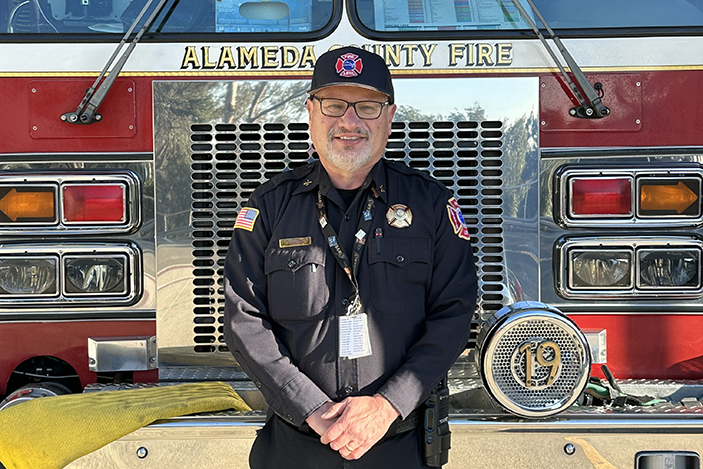Q: Was it much of a change coming to the Lab from a city fire department?
A: My job is to keep people safe at work, no matter where I work. At the Lab, fire inspectors need to know federal and state electrical, mechanical, building, and fire codes. When I worked at Livermore-Pleasanton, I needed to know local and state codes, but the Lab also follows federal codes.
What surprised me when I came to the Lab was the variety of the science. At the Lab, our job as fire inspectors is to provide a level of safety, so everyone goes home at the end of the day and to support our scientists so they can continue to make breakthroughs and discoveries that change the world.
Q: What does the typical day of a fire inspector at the Lab look like?
A: There is no ordinary day. We plan, but there is always something that comes up. For example, today, I started at 7 a.m. at the BioEPIC site examining material coming in for the building. I ensured the material was what was called for in the construction plan. At 8 a.m., I went next door to the IGB to do a material check on the roofing material. The plan called for staples an inch and three-quarters long, but the ones sent were only an inch and a quarter. That doesn’t sound like a big difference, but it is a fire-rated roof designed for high winds. Without the right staples, the roof could peel off in a storm.
Q: After your long career, is fire service in your blood?
A: It is. Whenever I review a building or the materials that go into it, I think of my family and friends. What if my wife, children, or grandson was in that building during an emergency? The other fire inspectors and I strive for the highest level of safety in all the Lab buildings. We always look for the weakest link in the chain that will compromise safety. I pay it forward by ensuring the next generation of fire inspectors is always focused on safety. I served as president of the Alameda County Fire Prevention Officers for three terms and have served for 20 years on the Executive Board of the Alameda County District Attorney’s Arson Task Force.
I’ve seen what happens when things go wrong. I’ve worked as a fire investigator for over 30 years, including the tragic Ghost Ship warehouse fire in Oakland in 2016, which claimed 36 lives. You must be aware when you are in buildings. If you are staying in a hotel, count the doors between your room and the closest exit. If it’s smoky, be prepared to stay low and crawl to the exit. Our largest fire ladders can only reach the sixth floor of a building. Be aware when you go into businesses of the location of the exits and take a minute to plan how you would get out of the building in an emergency. It sounds like I’m always planning for the worst, but that is the best way to be prepared and protect your loved ones and yourself.

6 Comments
Excellent write-up here. It is this type of inspection that makes our built environment first-rate. Congratulations to Mr. Dutchover on his full career of service.
Than you for your service, Wayne.
You will certainly be missed, Wayne. Congratulations on your retirement and best of luck, friend.
Wayne, thank you for your service and the work you have done to train the next generation of fire professionals. Have a wonderful retirement. It is well deserved.
Wayne, you were always a pleasure to work with, and your experience and wisdom will be sorely missed. I hope you enjoy your next adventure! You deserve it!
Congratulations! Thank you for your life-long dedication to public safety. Enjoy those retirement years!